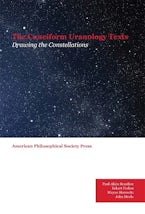Cuneiform Uranology Texts
Drawing the Constellations, Transactions, American Philosophical Society (Vol. 107, Part 2)
The American Philosophical Society Press Transactions of the American Philosophical Society132 Pages, 6.75 x 10.00 in
- eBook
- 9780871692740
- Published: January 2018
$45.00
BUYTo learn more about how to buy & access ebooks, please visit our Shopping Cart Guide
Customers outside of the Americas can buy books from our overseas distributor:

